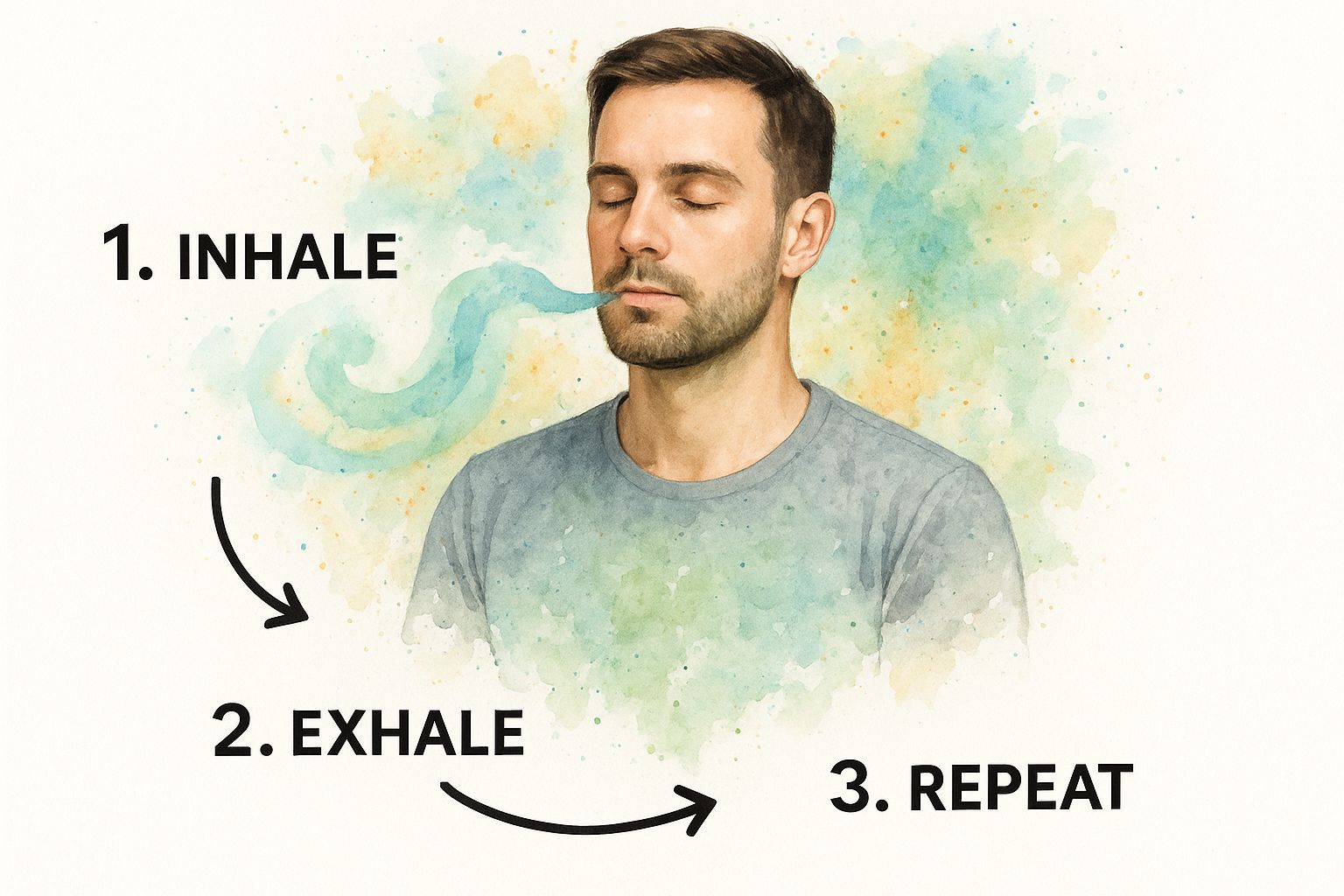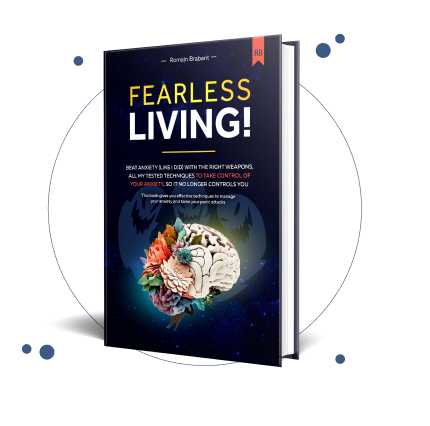
When you’re caught in the grip of anxiety, learning how to reduce it immediately isn’t just a nice-to-have—it’s a lifeline. The secret isn't some magic pill, but a personal toolkit of real-world techniques you can pull out the second panic starts to brew. It's all about interrupting that spiral and proving to yourself that you can find peace. It's about taking back control.
Your First Step Toward Immediate Calm and Hope
Feeling overwhelmed by anxiety is a heavy weight to carry, but you've come to the right place for support. This guide is built on a foundation of hope, designed to show you that immediate relief isn't just a fantasy—it's completely within your reach. And you're far from alone in this. Anxiety disorders are the most common mental illness in the U.S., affecting a staggering 40 million adults every year.
My goal here is to move beyond generic "just relax" advice. We're going to dive into practical, actionable techniques you can use the moment you feel that all-too-familiar dread creeping in, empowering you to create calm.
Believe in Your Ability to Heal
This might sound simple, but it's the most important step: you have to believe you can get better. Anxiety has a nasty habit of spinning a story of hopelessness, making you feel trapped and powerless. But that story isn't the truth.
Healing from anxiety and living a life free from constant panic is a reality for millions of people, and it can absolutely be your reality, too. What you're feeling is valid, and it's not a sign of weakness. It's your body and mind trying to protect you, even if that protective instinct has gone into overdrive. You can learn to work with it.
The greatest weapon against stress is our ability to choose one thought over another. By learning these techniques, you are choosing to empower yourself, proving that you have control over your response to anxiety and can heal.
Start Your Journey Now
You don't have to wait for the storm to pass on its own. You can learn to calm it yourself. Empowerment starts with knowledge and action, and every small step you take builds resilience for a future where you are in control.
This guide will walk you through the exact steps to:
- Use your breath to halt the panic response.
- Ground yourself firmly in the present moment.
- Shift your thoughts to regain a clearer perspective.
To get started, you might also find some great complementary advice in these 7 tips for calm anxiety fast from the Sachs Center. They offer some quick, actionable ideas that pair well with what we're about to cover.
You have the power to change your relationship with anxiety and begin to heal, starting today.
Immediate Anxiety Relief Techniques At a Glance
When you need to reduce anxiety immediately, use this table to quickly find a technique that works for you. Each method is designed for fast, effective relief, giving you hope that you can always find a way back to calm.
| Technique | How It Works | Best For |
|---|---|---|
| Box Breathing | Slows your heart rate and signals your nervous system to calm down. | Overwhelming panic, feeling out of breath, racing heart. |
| 5-4-3-2-1 Grounding | Engages your five senses to pull your focus out of anxious thoughts. | Dissociation, feeling detached, when your mind is racing. |
| Cognitive Reframing | Challenges the negative thought and replaces it with a more realistic one. | "What if?" spirals, catastrophizing, and self-critical thoughts. |
| Environmental Shift | Physically changes your surroundings to interrupt the anxiety cycle. | Feeling trapped, restless, or when a specific place triggers anxiety. |
Having a few of these in your back pocket gives you a sense of control and hope, which is often the first thing anxiety tries to take away.
Harness Your Breath to Instantly Halt Anxiety
Your breath is the most powerful and accessible tool you have for immediate anxiety relief. When panic strikes, your breathing instinctively becomes shallow and rapid, kicking your body's "fight or flight" response into high gear. But here's the hopeful truth: you can consciously reverse this process.
By taking control of your breath, you directly influence your nervous system. This isn’t just vague advice to "take a deep breath"; it's a science-backed method to signal to your body that you are safe. You're activating your parasympathetic nervous system, which is your body’s natural calming mechanism, designed to counter the stress response and bring you back to peace.
This infographic shows just how a single calming breath can start to recenter your mind and body.

As you can see, intentional breathing creates a cycle of calm that can break the feedback loop of panic, offering an immediate sense of control and a path back to yourself.
Diaphragmatic Breathing: Your First Step
One of the most effective methods is Diaphragmatic Breathing, also known as belly breathing. Instead of taking shallow sips of air into your chest, you focus on drawing breath deep into your belly.
Imagine you're in a stressful work meeting and feel that familiar knot of anxiety tightening in your stomach. You can practice this discreetly without anyone even noticing.
Place one hand on your chest and the other on your stomach. Inhale slowly through your nose for four seconds, feeling your stomach expand while your chest remains relatively still. Then, exhale slowly through your mouth for six seconds, feeling your stomach fall.
This simple action is incredibly powerful. Research confirms that deep, controlled breathing is a statistically supported method for reducing anxiety. Practicing diaphragmatic breathing at a rate of about six breaths per minute can significantly lower heart rate and cortisol levels. In fact, clinical trials show that after just 5 to 10 minutes of controlled breathing, people often report up to a 30% reduction in their perceived anxiety.
The 4-7-8 Breathing Technique
Another fantastic tool for your anxiety-fighting kit is the 4-7-8 method. Think of it as a natural tranquilizer for your nervous system. It’s particularly helpful when racing thoughts keep you awake at night or when you feel overwhelmed in public.
Here’s how to do it:
- Inhale quietly through your nose for a mental count of four.
- Hold your breath for a count of seven.
- Exhale completely through your mouth, making a whoosh sound, for a count of eight.
This cycle is one breath. Just repeat the process three more times for a total of four breaths. The held breath and long exhale are the secret sauce for activating that calming response.
This isn't just about managing a panic attack; it's about building a new, more peaceful relationship with your body. Every time you consciously regulate your breath, you're teaching your nervous system a new, calmer way to respond to stress. You're proving to yourself that you have the power to find calm, no matter where you are.
For a deeper dive into different methods, check out our complete guide on breathing exercises for anxiety. Mastering these techniques is a huge step toward living a life where you feel prepared and empowered, not panicked.
Use Your Senses with Grounding Techniques That Work Fast

When anxiety sends your thoughts spiraling into a vortex of "what ifs," grounding techniques are your anchor back to the present. This isn't about ignoring what you're feeling. It's about interrupting that frantic feedback loop by pulling your attention out of your racing mind and into the physical world.
The hopeful truth is that you can stop this spiral. You have the power to step out of the storm and find solid ground, even when it feels like everything is shaking. Grounding is a skill that proves you can regain control and find safety, moment by moment.
The 5-4-3-2-1 Method: A Lifeline for Your Senses
One of the most effective and trusted grounding techniques is the 5-4-3-2-1 method. It's beautifully simple yet profoundly effective because it forces your brain to focus on something other than its own fear. The best part? You can do this anywhere, anytime, and no one even has to know.
Here’s how you can use it to dial down anxiety right now:
- 5 Things You Can See: Look around you. Name five things you can see. Don't just list them; notice the details. "I see the blue pen on my desk, the grain of the wood, the dust on the lampshade, the crack in the ceiling, the green leaves on the plant outside."
- 4 Things You Can Feel: Shift your awareness to physical sensations. Notice four things you can touch. Maybe it's the texture of your jeans, the smoothness of your phone screen, the feeling of your feet flat on the floor, or the cool air from a vent on your skin.
- 3 Things You Can Hear: Listen carefully. Identify three distinct sounds. It might be the hum of your computer, the distant sound of traffic, or even the sound of your own steadying breath.
- 2 Things You Can Smell: Focus on what you can smell. This might be faint, like the scent of an old book or the clean smell of laundry on your clothes. If you can't smell anything right now, simply imagine two of your favorite scents.
- 1 Thing You Can Taste: Finally, notice one thing you can taste. This could be the lingering taste of coffee, or you can take a sip of water and focus on its taste and temperature.
This technique doesn’t just distract you; it brings you back into your body, proving that you are safe in the here and now.
More Sensory Anchors for Instant Calm
Beyond the 5-4-3-2-1 method, other sensory-based tactics can work wonders. The goal is to find what works for you—to build a personal toolkit of reliable anchors for when you need them most.
Remember, grounding isn't about making anxiety disappear forever in one go. It's about taking back the present moment. Each time you ground yourself, you are retraining your brain and reaffirming your own strength and capacity for peace.
Consider trying these simple but powerful actions:
- Hold an Ice Cube: The intense, sharp sensation of cold is difficult to ignore. It demands your full attention, effectively short-circuiting a thought spiral.
- Plant Your Feet: Wherever you are—sitting or standing—press your feet firmly into the floor. Feel the solid ground beneath you, supporting you. Remind yourself, "I am steady. I am supported."
- Inhale a Calming Scent: Carry a small bottle of lavender essential oil or a sachet of chamomile. A quick, deep inhale can have an almost immediate calming effect on your nervous system.
These aren't just tricks; they are tangible ways to reconnect with reality when your mind is trying to convince you of a catastrophe. For more ideas, you can explore a wide variety of grounding techniques for anxiety to find even more methods that resonate with you and your journey to healing.
Shift Your Mindset with Cognitive Tools for Quick Relief

Anxiety often feels like your own mind has turned against you, trapping you in an endless loop of worst-case scenarios. But here’s the beautiful truth: you can learn to challenge that story. You don’t have to be a prisoner of your thoughts; you can become their guide.
This isn’t about diving into deep, long-term therapy right this second. Think of these as mental "pattern interrupts"—quick, powerful techniques designed to give you immediate relief when you need it most.
They work by creating a sliver of space between you and your anxiety. That space is everything. It's proof that you have the power to shift your perspective and find calm, even when your mind is screaming otherwise. It’s a glimpse of the panic-free life that is possible.
Challenge Catastrophic Thinking
When anxiety hits, our minds are experts at jumping to the absolute worst conclusion. This is called catastrophizing. A minor work mistake instantly becomes, "I'm definitely getting fired." A text message left on read means, "They're furious with me." Sound familiar?
The secret to learning how to reduce anxiety immediately is to stop accepting these thoughts as facts. Instead, become a gentle detective of your own mind.
Ask yourself these simple questions:
- What’s a more realistic or likely outcome here?
- What evidence do I actually have to back up this fear?
- Have I been in a spot like this before? What happened then?
These questions break the spell of panic. You’re not trying to pretend the fear isn’t there. You’re just checking to see if it’s telling you the whole truth. More often than not, you'll find it’s just exaggerating, which helps you reclaim your sense of control and hope.
A powerful takeaway is that you don't have to believe every thought that pops into your head. Your thoughts are just suggestions, not commands. You have the power to observe them, question them, and choose a more balanced, hopeful perspective.
Create Distance with Cognitive Defusion
Here’s a game-changing concept from modern therapy: cognitive defusion. It’s the practice of seeing your thoughts for what they are—just words and images floating through your mind—instead of getting tangled up and dragged away by them.
Imagine your anxious thought is a single leaf floating down a stream. You can just watch it drift by. You don't have to jump into the cold water to chase it.
Try this simple exercise. The next time an anxious thought shows up, just label it. Say to yourself, "I'm having the thought that I might fail this presentation."
That tiny shift in language creates instant distance. You are not the thought; you are the observer of the thought. It's a cornerstone technique in many effective therapies, and for good reason.
If you're curious about the science behind these tools, our guide to understanding CBT for anxiety offers a fantastic look at how changing your thought patterns can lead to lasting peace. This simple act of reframing proves you can live a life where panic doesn't call the shots.
Move Your Body for a Calmer Mind
The link between your body and mind is incredibly powerful, especially when anxiety flares up. When you feel that familiar surge of panic, your body gets flooded with stress hormones like adrenaline and cortisol. This creates a restless, jittery energy that practically begs for an outlet.
And here’s the most hopeful part: you can give it one, right now.
Physical movement is one of the fastest and most effective ways to burn off this anxious energy. This isn't about signing up for a grueling, hour-long workout. We’re talking about simple, immediate actions you can take anywhere to prove to yourself that you can get back in the driver's seat.
The Power of Quick Bursts of Movement
Picture this: you're at your desk, heart hammering after reading a stressful email. Instead of just sitting there and letting that feeling fester, get up. Do a few minutes of intense stretching, really focusing on the tight muscles in your neck and shoulders where we all hold our tension.
Even a single minute of jumping jacks or running in place can be enough to interrupt the anxiety cycle. It works.
This is effective because physical activity tells your brain to release mood-boosting chemicals called endorphins. Think of them as your body's own natural "feel-good" chemicals. They act as a powerful antidote to the stress hormones fueling your distress, offering almost immediate relief.
The empowering truth is that your body holds a key to calming your mind. By choosing to move, you are actively participating in your own healing. You're showing yourself that a physical release is a direct and reliable path back to mental calm.
Turning Movement into a Reliable Tool
Using exercise to fight anxiety isn't just a nice idea—it's a well-documented and statistically proven method for immediate relief.
Engaging in moderate aerobic exercise, like a brisk walk or jog for just 10 to 15 minutes, can trigger the release of not only endorphins but also key neurotransmitters like serotonin and dopamine that help regulate your mood. In fact, research shows a single session of moderate exercise can decrease anxiety by approximately 20% to 25%. That's a significant and tangible shift you can feel almost right away.
When you make this a regular habit, you start building a solid foundation of resilience.
- Take a "Worry Walk": The next time you feel overwhelmed, let that be your cue. Go for a brisk 10-minute walk outside. Focus on the feeling of your feet hitting the pavement and the fresh air on your skin.
- Create a "Reset Routine": Find a few simple movements you can do anywhere—think deep lunges, arm circles, or torso twists. Use this short sequence to reset your nervous system whenever you feel stress creeping in.
- Dance It Out: Put on your favorite upbeat song and just move. No choreography, no judgment. Just let your body respond to the music. This combines the physical release with the pure joy of music.
These small, consistent actions do more than just manage a single moment of panic. They build a powerful belief in your own ability to self-regulate and heal.
Over time, you’ll find that integrating movement perfectly complements other positive habits. Our guide on lifestyle and diet changes for anxiety management can show you how all these pieces work together for long-term peace. You're not just fighting anxiety; you are actively building a stronger, calmer, and more hopeful future for yourself.
From Immediate Relief to Lasting Peace
You’ve just armed yourself with a whole host of powerful tools—breathing exercises, grounding techniques, and cognitive shifts designed to help you figure out how to reduce anxiety immediately. These are your go-to allies in those moments of overwhelm, but the real goal here is bigger than just getting through a panic attack. It's about building a life where peace is the default, not the exception.
The most freeing truth is this: a future without the constant hum of anxiety isn't a fantasy. It's completely within your reach.
This whole journey, from finding quick relief to achieving long-term healing, is all about turning these skills into second nature. When you practice them, even on the good days when you feel totally calm, you're doing something profound. You're rewiring your nervous system and building deep, unshakable resilience. You're essentially teaching your mind and body a new, calmer way to live.
Every time you use a grounding technique or question an anxious thought, you're casting a vote for a more empowered you. This isn't just about fending off panic; it's about laying down a rock-solid foundation for a calmer, more confident life.
Don't forget that every small step you take is a huge win. You are proving to yourself, one breath at a time, that you have the strength to heal. To help map out this path, you can explore a more structured approach with these anxiety recovery steps, which show how these individual actions fit into the bigger picture of sustained wellness.
You’re not just surviving anymore. You're actively building a life where you feel in control, hopeful, and genuinely at peace.
Answering Your Questions
It's completely normal to have questions as you start exploring these tools. Let's tackle some of the most common ones I hear, so you can move forward with clarity and confidence on your path to healing.
How Long Until I Feel a Difference?
This is probably the most common question I get. The great thing about techniques like diaphragmatic breathing or the 5-4-3-2-1 grounding method is that they're designed for immediate relief. You should start feeling a noticeable shift within just a few minutes because they work by directly signaling to your nervous system that the danger has passed.
But the real magic happens with consistency. Think of it like building muscle. The more you practice these tools, especially when you’re not feeling anxious, the stronger and more automatic they become. This is how you build a deep, unshakable trust in your own ability to find calm and heal.
What If a Technique Just Isn't Working for Me?
First off, that’s perfectly okay—and totally expected. Nobody masters every single tool in the toolkit. The whole point is to find what resonates with you. What feels like a lifesaver for one person might not click for another, and that’s fine. What helps you on a Tuesday might not be what you need on a Friday.
For instance, if you're in a moment of high-intensity anxiety, trying to rationally challenge your thoughts can feel like trying to reason with a hurricane. It's just too much. In that moment, switching to something physical—like grabbing an ice cube or doing a few intense wall push-ups—might be far more effective.
The real power isn't in finding one single "cure," but in knowing you have a whole collection of strategies to choose from. It’s about having options so you’re never left feeling stuck or hopeless.
Is It Really Possible to Live a Life Without Constant Panic?
Yes. Absolutely, yes. While anxiety is a natural human emotion that none of us will ever eliminate completely (nor would we want to!), living in a state of constant, gut-wrenching fear is not a life sentence. You don't have to accept that as your reality.
Every time you use these tools, you're doing more than just putting out a fire. You are actively retraining your brain and rewiring your nervous system for safety and resilience. Over time, this consistent effort dramatically lowers the frequency and intensity of panic, clearing the path for a life that feels full, hopeful, and yours again. You get back in the driver's seat.
At The Anxiety Checklist, we're committed to the belief that a life free from the grip of panic is achievable for everyone. Our Fearless Living system is designed to help you transform these immediate relief strategies into lasting peace. Take the next step in your healing journey and discover the calmer future you deserve.
Learn more about our comprehensive guide and start taking control today.

